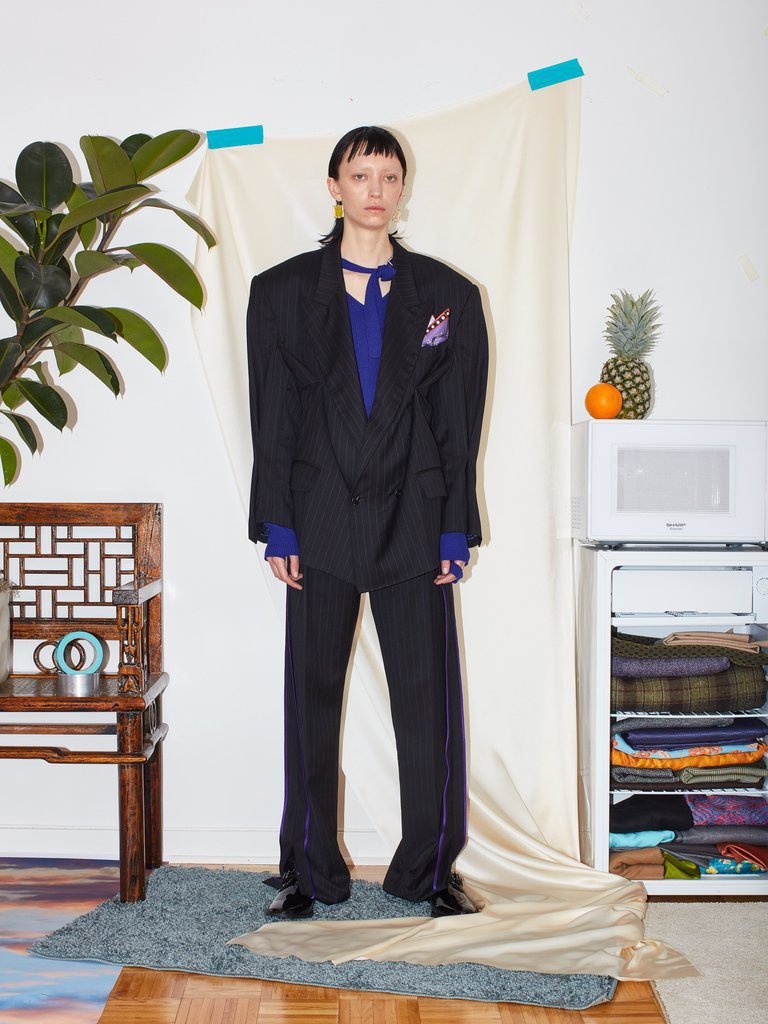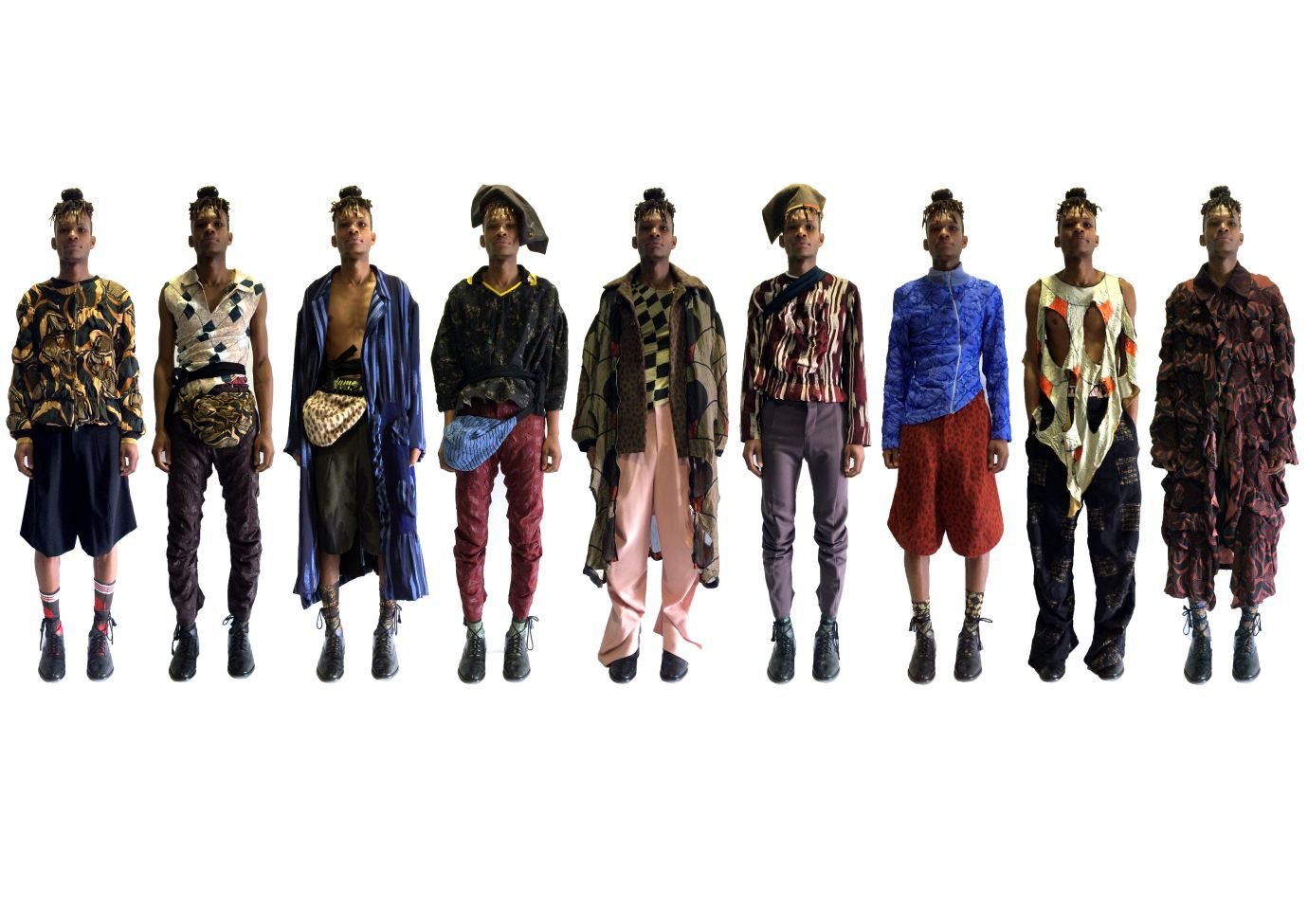If machine knitting is an algorithmic process, Jessica Guzman strives to glitch the system. Her work finds irruptions of chaos within the highly ordered protocols of knitting. While we tend to think of warps, blurs, and glitches as subversive flaws, Guzman sees them as the norm and perfection as the ultimate error. To knit a twisty, bunched-up, lopsided garment, then is simply an act of honesty. “It’s not a distortion, it’s allowing the thing to do what it intrinsically wants to do.”
Jessica Guzman on machine-knitting careful chaos
Can you manufacture the same garment differently every time? Jessica Guzman’s semi-elasticated knits say yes.
Guzman grew up in Sydney, Australia, where she studied fashion design and international studies at the University of Technology Sydney. There she discovered a natural affinity for machine knitting. “There’s a childishness to the play of knitting,” she says. “I gravitated towards it. It just felt right.” She recalls three years of ferocious experimentation and her eagerness to try out all the new knitwear machines as soon as they arrived at school.
“I wanted to do the same thing multiple times and each time get a different result.”
Her love of tinkering around continued to flourish after she joined the Parsons MFA. Over the course of the program, she came to realize that the design and production of a garment work very differently. You design a garment once through a specialized and distinct process, never to be repeated. But then to produce that garment, you repeat a limited protocol of actions over and over until the order is complete. Guzman decided her practice should intervene here, finding a middle ground between the singularity of design and the multiplicity of production. “I wanted to do the same thing multiple times and each time get a different result,” she says.
She began by experimenting with repetition through photos, printing the same image multiple times onto different surfaces which she primed with chemicals for added variation. Oil bubbles the ink to form a pointillist image. Windex cleaner alone casts a blue pallor over the image, but used alongside glue it blurs and contorts the image into abstraction. Through these studies, Guzman discovered a grammar of printmaking for her collection: how to warp a photo enough to defamiliarize the image but not so much that it becomes unrecognizable. “A lot of the prints I did weren’t digitally manipulated, they’re all done through printing on different types of plastics that have been coated,” she explains. “The materials are allowed to mutate, to follow their own paths and create their own destinies.”
Ever the knitwear enthusiast, Guzman wondered how a sweater might mutate to find its own destiny. She started to play around. “I was very methodical about it,” she says. “I would knit a whole lot of fabric, paint it, and then I would unravel it and knit it again,” photographing each iteration of the panel. With each reprocessing came a slight remix. “What happens if I do a bigger stitch? What happens if I paint the yarn first and then I knit it? It was so exciting,” she says. Slowly the incremental changes accrued into a dizzying array of photographs, samples, and micro-techniques. “It’s essentially an ecosystem,” she realized, a world of evolution, interrelation, and adaptation.
Structuring her research into a collection, she worried that incorporating too many different techniques would create an incomprehensible mess. “I had so many ideas, but I wanted to tell this story precisely and cleanly,” she says. So she decided to pare back all the formal complexity of her knits to a binary code: elastic and inelastic yarns, which together could yield infinite permutations. Thus she could infuse archetypal garments, say, “ a t-shirt, a pair of jeans, a jacket,” with an element of randomness. She orchestrated an unpredictable tension between the two yarns so every knitted garment would come out differently each time. “I think it’s so exciting, having a hundred pieces of the same garment and each one is a unique shape.”
The final collection synthesizes her print and knitwear developments. On a floral printed dress, ever-so-askew flowers blur easily into ruched scrunches. The elastication also bleeds into leather and denim, crumpling the stiff fabrics into soft folds and nubby textures. White t-shirts bear poetic slogans only legible when worn – Guzman printed the words on plastic pieces which she fused onto knits while they were stretched out.
Immediately after the pandemic forced Parsons to close its studios, she relocated to Los Angeles. The move afforded her more space and a fresh outlook – not to mention manufacturing connections to help her produce the work. It was crucial to her concept that she works closely with the people producing her work and hear their input, breaking down the distinction between designer and machinist. “Everyone’s time should be valued,” she says.
“I’m just trying to find a way to live that I’m happy with and satisfies me creatively and allows me to live financially. That’s what we’re all doing.”
Guzman remains in Los Angeles, where she plans to stay for the near future. “There’s a really cool knit community in LA,” she says. “I’m super content.” She’s been working as a knitwear sample maker for Eckhaus Latta, which she plans to continue as she figures out the future of her own practice. “I’m just trying to find a way to live that I’m happy with and satisfies me creatively and allows me to live financially. That’s what we’re all doing.”

































